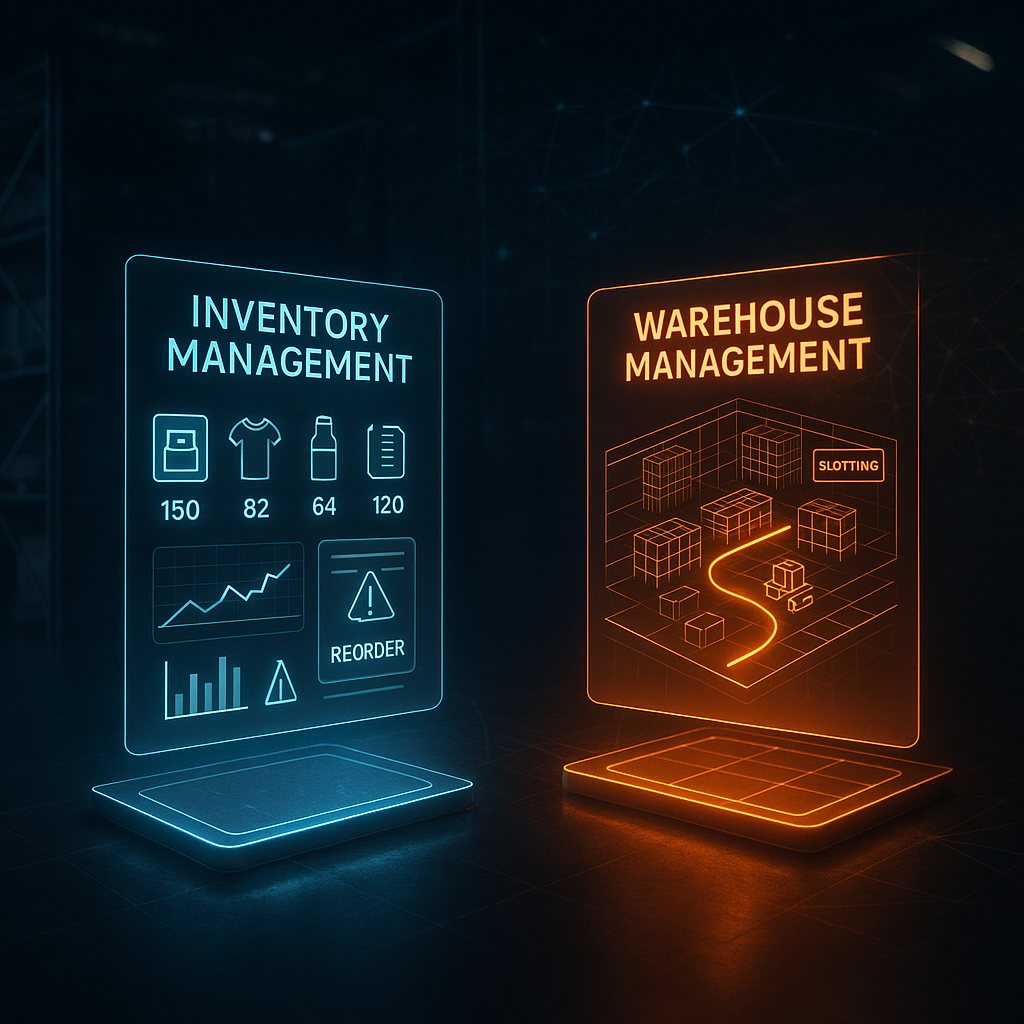How Does a Warehouse Management System Work?
Are you battling frequent stock inaccuracies, late shipments, or labor inefficiency? As of 2024, the global warehouse management system market was...
In the 1990's we started a software company with a team spread-out across the country working remotely. No software solution existed that would allow us to streamline our operations and improve efficiency - so we built our own.
“Working at NEX has been a game-changer for me. I’ve never been part of a team so committed to innovation and collaboration. Every day, I feel like my ideas truly make an impact.”
— Jordan M., Product Manager

Discover how NEX significantly enhanced First Atlantic Commerce's
operations, billing processes, and overall data management efficiency.
Warehouse Management Systems (WMS) are essential for optimizing warehouse operations. They provide real-time inventory tracking and streamline processes like picking, packing, shipping, and replenishment. Integrating with systems like Enterprise Resource Planning (ERP) and Transportation Management Systems (TMS), WMS enhance overall supply chain efficiency, enabling businesses to meet market demands more effectively. Read on to learn how a WMS can transform your warehouse operations and drive business growth.
TL;DR: A Warehouse Management System (WMS) is software that optimizes warehouse operations through real-time inventory tracking and process coordination. Key features include inventory management, labor management, yard and dock management, and order processing. Inventory management involves real-time tracking of inventory levels and locations, while labor management focuses on optimizing workforce productivity and task assignments. Yard and dock management ensures efficient movement of goods in and out of the warehouse, and order processing streamlines the handling of customer orders from picking to shipping.
A Warehouse Management System (WMS) is software that optimizes warehouse operations. It provides real-time inventory tracking from receipt to shipment, coordinating activities like picking, packing, shipping, and replenishment. By integrating with systems such as Enterprise Resource Planning (ERP) and Transportation Management Systems (TMS), a WMS improves overall supply chain efficiency.
Beyond inventory management, a WMS includes features for labor management, yard and dock management, and order processing. It optimizes workforce productivity by assigning tasks based on skills and availability, ensures smooth movement of goods to reduce delays, and streamlines order handling for accurate deliveries. These features are crucial for maintaining high service levels and customer satisfaction.
WMS supports scalability, allowing businesses to adapt to market demands and expand operations without losing efficiency. Overall, a robust Warehouse Management System (WMS) streamlines all aspects of warehouse operations, including receiving, put-away, picking, packing, shipping, inventory tracking, and replenishment.
Modern warehouses need to handle larger volumes of goods accurately and quickly. A WMS provides real-time inventory visibility and automates key processes, reducing errors and ensuring accurate inventory levels. This improves order fulfillment rates and customer satisfaction, enabling efficient operations in a dynamic market.
A WMS also plays a key role in cost management and resource optimization. Labor is a significant warehouse expense, and inefficient processes can lead to unnecessary costs. A WMS automates task assignments and monitors performance, ensuring effective use of human resources. It also optimizes space and inventory turnover, reducing waste and overhead costs, leading to substantial savings and a stronger bottom line. Advanced analytics offer insights into inefficiencies, supporting continuous improvement.
As companies expand, managing warehouse activities becomes more complex. With the rise of e-commerce and omnichannel retailing, a WMS is essential for managing diverse fulfillment channels and ensuring a cohesive supply chain. A WMS is not just for managing warehouse operations; it's a strategic asset driving business growth and success.
Warehouse Management Systems (WMS) come in several types, tailored to various operational needs and business scales. The main types are standalone systems, ERP (Enterprise Resource Planning) integrated systems, cloud-based systems, and supply chain execution modules.
These are dedicated software solutions focusing solely on warehouse operations. They offer robust functionalities for inventory control, order management, and labor management. Standalone WMS are ideal for businesses needing specialized, in-depth features for managing their warehouse independently from other operations.
These systems are part of broader ERP systems managing various business processes, including accounting, HR, and supply chain management. ERP-integrated WMS ensure seamless data synchronization across departments, allowing for better coordination and visibility across the enterprise. However, their complexity can be a challenge for smaller businesses that might not need extensive integration or have limited resources.
These systems are popular for their flexibility, scalability, and cost-effectiveness. Hosted on remote servers and accessed via the internet, cloud-based WMS eliminate the need for significant upfront investments in hardware and IT infrastructure. They offer real-time data access, which is beneficial for businesses with multiple warehouses or remote operations. Additionally, they are easily scalable, allowing businesses to adjust their capabilities as they grow.
Designed to enhance and integrate with existing supply chain management systems, these modules provide advanced features like transportation management, order fulfillment, and supplier collaboration. This type of WMS is ideal for businesses aiming to optimize their entire supply chain rather than just warehouse operations.
A cloud-based Warehouse Management System (WMS) operates via internet connectivity, allowing access from anywhere without the need for on-premise infrastructure. Hosted on remote servers managed by a third-party provider, it ensures all warehouse data is consistently updated and accessible in real-time. When tasks like receiving goods, picking orders, or shipping products are performed, these activities are recorded and synchronized within the cloud, providing accurate information to all users across the organization.
A cloud-based WMS streamlines operations with automated processes. It uses barcode scanning and RFID technology to track inventory movement, ensuring precise handling of goods. Automated workflows guide personnel through tasks, optimizing picking, packing, and shipping to minimize errors and boost productivity. Additionally, it integrates seamlessly with other systems like ERP and Transportation Management Systems (TMS), providing comprehensive oversight of supply chain activities. This integration ensures inventory and order information is aligned with sales, procurement, and logistics.
Implementing a Warehouse Management System (WMS) offers several key benefits that enhance warehouse operations. A WMS provides real-time tracking of inventory levels, locations, and movements, reducing errors and discrepancies. This ensures optimal stock levels, preventing overstocking and stockouts, and helping businesses meet customer demands reliably, boosting satisfaction and loyalty.
By automating and optimizing processes like picking, packing, shipping, and receiving, a WMS minimizes manual interventions and streamlines workflows. This results in faster processing times, reduced labor costs, and fewer errors. A WMS also enhances labor productivity by assigning tasks based on availability and skill, ensuring effective use of resources. Features like automated replenishment and real-time analytics enable proactive decision-making, allowing swift responses to market changes and operational needs.
A WMS optimizes space utilization and improves inventory turnover, reducing storage costs and maximizing warehouse space use. Its seamless integration with other systems, such as ERP and Transportation Management Systems (TMS), ensures an efficient supply chain, further lowering operational costs. The scalability of a WMS allows businesses to expand operations without significant additional investments in infrastructure. It provides the flexibility to handle seasonal fluctuations and long-term growth, ensuring better resource management, cost-efficiency, and improved business performance.
To successfully implement a Warehouse Management System (WMS), start by evaluating your current warehouse operations to identify pain points like inventory management, order fulfillment, labor productivity, and efficiency. This helps in choosing a WMS that fits your business needs. Ensure the WMS can integrate with existing systems, such as ERP and TMS, to improve supply chain coordination. Check if the WMS is scalable to accommodate growth, including increased inventory and new warehouse locations.
Training and change management are crucial. Comprehensive training helps staff adapt to the new system and understand its benefits, while fostering a culture of adaptability reduces resistance to change. Focusing on thorough planning, seamless integration, and effective training will optimize WMS benefits and lead to long-term operational success.
Optimizing warehouse operations with a Warehouse Management System (WMS) uses advanced technology to streamline processes and enhance efficiency. Real-time inventory management provides up-to-the-minute visibility into stock levels, reducing the risk of overstocking or stockouts, aiding in better decision-making, and improving customer satisfaction. A WMS automates tasks like picking, packing, and shipping, using algorithms to determine the most efficient routes, thus increasing productivity and reducing labor costs.
Additionally, a WMS enhances labor management by optimizing workforce performance. It assigns tasks based on availability and skills, ensuring the right people are in the right places. Performance metrics and reporting features allow managers to track productivity and identify areas for improvement. With these insights, businesses can implement targeted training and adjust staffing levels to meet demand fluctuations effectively. Overall, a WMS is critical for transforming warehouse operations, driving efficiencies, and supporting business growth.
Selecting the right Warehouse Management System (WMS) is crucial for optimizing warehouse operations and achieving business goals. Start with a thorough needs assessment to analyze current operations, identify pain points, and determine specific requirements like inventory management, integration needs, and scalability. This helps outline essential features for your ideal WMS and ensures it can grow with your business objectives.
Integration capabilities are key; the WMS must seamlessly integrate with systems like Enterprise Resource Planning (ERP) and Transportation Management Systems (TMS) to maintain real-time visibility and coordination across departments. Evaluate the WMS’s compatibility with current technology and future integration needs. Additionally, choose a vendor with a reliable system, excellent support, and ongoing training. Consider their track record, industry experience, customer reviews, and total cost of ownership, including implementation, licensing, and maintenance. By evaluating your needs, integration capabilities, and vendor options, you can select a WMS that aligns with your business goals and drives operational excellence.
Integrating a Warehouse Management System (WMS) with other business systems is essential for a seamless and efficient supply chain. A primary integration is with Enterprise Resource Planning (ERP) systems. Connecting the WMS with ERP synchronizes inventory data, financial information, and order processing, providing all departments with accurate, up-to-date information.
Another critical integration is with Transportation Management Systems (TMS), which handle logistics such as route planning, carrier selection, and freight tracking. Integrating WMS with TMS streamlines the order fulfillment process from warehouse picking and packing to shipping and delivery.
Integrating WMS with Customer Relationship Management (CRM) systems and e-commerce platforms further enhances efficiency. A WMS integrated with CRM provides sales teams with real-time inventory insights, allowing them to manage customer expectations and avoid overselling. Integration with e-commerce platforms automates order processing, ensuring online orders are quickly and accurately picked, packed, and shipped. These integrations create a cohesive operation where data flows seamlessly across systems, reducing manual data entry, minimizing errors, and providing a holistic view of the business.
A Warehouse Management System (WMS) is essential for optimizing warehouse operations through real-time inventory tracking, automated processes, and seamless integration with other business systems. Implementing a WMS enhances efficiency, reduces costs, and improves customer satisfaction. As technology evolves, the future of WMS will bring further advancements in automation, connectivity, and sustainability, making it a critical component of modern supply chain management. With careful selection and integration, a WMS can transform warehouse operations and drive long-term business success.
For a practical demonstration of how the latest inventory management technologies can enhance your business's operational visibility and efficiency, consider a personalized demo with NEX. Discover how NEX can help your business tackle inventory management complexities and secure a competitive edge in the market. For more information, visit https://www.nexdriver.com.

Are you battling frequent stock inaccuracies, late shipments, or labor inefficiency? As of 2024, the global warehouse management system market was...

5 min read
Choosing between inventory and warehouse management systems is overwhelming—especially for SMBs managing tight budgets. According to McKinsey,

Still using spreadsheets to manage inventory? Struggling with mispicks, slow fulfillment, or constant inventory errors? These challenges are common,...